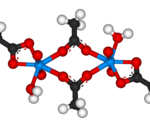1. PRODUCT AND COMPANY INFORMATION
Product Identifiers
Name: Uranium Ammonium Acetate
Formula: (NH3OH)[UO2(CH3COO)3]
Identified uses: Laboratory chemicals, manufacture of substances.
Supplier
IBI Labs
3495 N. Dixie Hwy. Unit # 8
Boca Raton, FL 33431
Tel: 561-826-0061 Fax: 561-892-8450
Emergency Telephone Numbers
INFOTRAC
USA & Canada contact number: 1-800-535-5053
International contact number: 1-352-323-3500
2. FIRST AID MEASURES
Description of First Aid Measures
General advice:
- Consult a physician.
- Show this safety data sheet to the doctor in attendance.
- Move out of dangerous areas.
If inhaled:
- If breathed in, move the person into fresh air.
- If not breathing, give artificial respiration.
- Consult a physician.
In case of skin contact:
- Wash off with soap and plenty of water.
- Take the patient immediately to the hospital.
- Consult a physician.
In case of eye contact: Rinse thoroughly with plenty of water for at least 15 minutes and consult a physician.
If ingested:
- Never give anything by mouth to an unconscious person.
- Rinse mouth with water.
- Consult a physician.
3. FIREFIGHTING MEASURES
- Use appropriate media to suppress exposure to fire.
- Contain runoff.
Advice for firefighters: Wear self-contained breathing apparatus for firefighting if necessary.
4. ACCIDENTAL RELEASE MEASURES
Personal precautions, protective equipment, and emergency procedures:
- Wear respiratory protection.
- Avoid dust formation.
- Avoid breathing vapors, mist, or gas.
- Ensure adequate ventilation.
- Evacuate personnel to safe areas.
- Avoid breathing dust.
Environmental precautions:
- Prevent further leakage or spillage if it is safe to do so.
- Do not let the product enter drains.
- Discharge into the environment must be avoided.
Methods and materials for containment and cleaning up:
- Pick up and arrange disposal without creating dust.
- Sweep up and shovel.
- Keep in suitable, closed containers for disposal.
5. HANDLING AND STORAGE
Precautions for safe handling:
- Avoid contact with skin and eyes.
- Avoid the formation of dust and aerosols.
- Provide appropriate exhaust ventilation at places where dust is formed.
For precautions see section 2.
Conditions for safe storage, including incompatibilities: Keep the container tightly closed in a dry and well-ventilated place.
Specific end uses: Apart from the uses mentioned in section 1 no other specific uses are stipulated.
6. EXPOSURE CONTROLS AND PERSONAL PROTECTION
Exposure Controls
Appropriate engineering controls:
- Avoid contact with skin, eyes, and clothing.
- Wash hands before breaks, and immediately after handling the product.
Personal Protective Equipment
Eye and face protection:
- Face shield, and safety glasses.
- Use equipment for eye protection tested and approved under appropriate government standards such as NIOSH (US) or EN 166(EU).
Skin protection:
- Handle with gloves.
- Gloves must be inspected before use.
- Use proper glove removal technique (without touching the glove’s outer surface) to avoid skin contact with this product.
- Dispose of contaminated gloves after use following applicable laws, and good laboratory practices.
- Wash and dry hands.
Body Protection: Complete suit protecting against chemicals, the type of protective equipment must be selected according to the concentration and amount of the dangerous substance at the specific workplace.
Respiratory protection: Where risk assessment shows air-purifying respirators are appropriate use a full-face particle respirator type N100 (US) or type P3 (EN 143) respirator cartridges as a backup to engineering controls. If the respirator is the sole means of protection, use a full-face supplied air respirator. Use respirators and components tested and approved under appropriate government standards such as NIOSH (US) or CEN (EU).
Control of environmental exposure
- Prevent further leakage or spillage if it is safe to do so.
- Do not let the product enter drains.
- Discharge into the environment must be avoided.
7. DISPOSAL CONSIDERATIONS
Product:
- Offer surplus and non-recyclable solutions to a licensed disposal company.
- Contact a licensed professional waste disposal service to dispose of this material.
- Dissolve or mix the material with a combustible solvent and burn it in a chemical incinerator equipped with an afterburner and scrubber.
Contaminated packaging: Dispose of it as an unused product.
8. TRANSPORT INFORMATION
The U.S. Department of Transportation (D.O.T.) Code of Federal Regulations (49 CFR Parts 100-185), the International Air Transportation Association (IATA), the International Civil Aviation Organization (ICAO), and the International Maritime Organization (IMDG) are all factored into the classification and transport of material.
Proper Shipping Name:
Hazard Class:
UN/ID Number: To be determined on a case-by-case basis.
Special Information:
Packing Group:
The classification of substances with multiple hazards must be determined following the criteria presented in the regulations mentioned above. Due to the various quantities and combinations of materials being shipped at one time, the information above must be determined based on the characteristics of the specific shipment.
9. OTHER INFORMATION
Copyright 2014 IBI Labs. License granted to make unlimited paper copies for internal use only.
IBI Labs requires that those who receive their materials comply with 29 CFR 1910.1200(h), which mandates that employers provide employees with effective information and training about hazardous chemicals in their workplace.
The contents of this document are believed to be accurate as of the date of revision and are provided in good faith. However, it is recommended that recipients use this information as supplementary and exercise caution and judgment regarding its accuracy and suitability. Please note that IBI Labs cannot be held responsible for any damage, direct or indirect, that occurs because of using the information provided in this Safety Data Sheet.
IBI Labs makes no warranties, expressed or implied, including warranties of merchantability and fitness for a particular purpose. This information is provided without warranty, and any use of the product that does not conform to this Safety Data Sheet, or that is used in combination with any other product or process, is the user’s responsibility.
Revision Date: 07/24/2024



